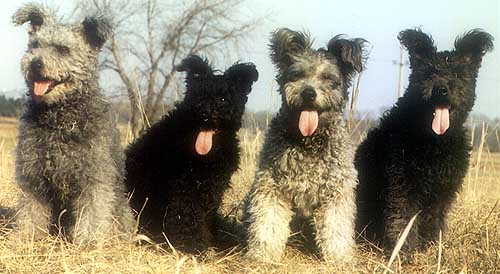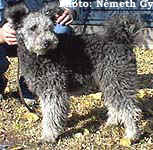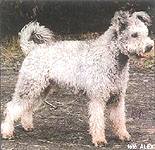PUMI COLOURS
Part III. Unknown action.
Progressive Greying series — G gene
Little (1957) described greying as a progressive change resulting in a lightening of the hair coat as the dog ages. He suggested that this could be a dilution gene but it is not like those dilution gene, which causes pups to be born a diluted color and remain so. Progressive greying also occurs in horses and that trait was recently mapped to horse chromosome 25. The gene that causes this in dogs, has not yet been discovered.

Although only two genes were recognised in this series by Little, this may be a more complex locus, or genes that affect greying may reside at more than one locus. The effect of G, in single or double dose, is the replacement of colored by uncolored hairs as the animal ages, very much like premature greying in human beings. This gene should be suspected in any breed where a dark puppy pales and washes out with age, and the paling is due to interspersed white hairs. The gene is almost certainly present in some Poodles, Old English Sheepdogs, terriers and Pumis. The fading may start immediately after birth or after a period of weeks to months has elapsed, and may go as far as it is going to by the first adult coat or may continue through the animal's lifetime. G may or may not be the gene involved in the greying of muzzle and over the eyes in aged dogs, or in the lightening of black to steel blue without interspersed white hairs. This is a series that definitely needs more work.
My own experience and study of Pumi pedigrees is consistent with the interpretation that grizzled-grey (many black with some grizzled hair) and silver-grey may be produced or by separate genes in G series or by genes, which are located in separate locuses. Let’s call the progressive greying (silver-greying) allele — G. It is given a capital letter because it is an incompletely (semi-) dominant. This gene has a «silvering» (lightening) effect not only on eumelanin, but on phaeomelanin too.
In other words, if a Pumi has gg alleles, it would be black (genotype: Ay-, E-, K-, gg) or black-sabled red colour (genotype: Ay-, E-, kk, gg) , Gg — would be a dark-grey (genotype: Ay-, E-, K-, Gg) or dark-grey-sabled yellow colour (genotype: Ay -, E-, kk, Gg) and GG — would be silver (genotype: Ay-, E-, K-, GG) or silver-sabled cream colour (genotype: Ay-, E-, kk, GG).
Both dark-greys and silvers are born black and become grey during the first year, or sometimes even later. Consequently, many of Pumis are registered as black and this is never changed in the official pedigree records. In addition, some are registered as grey or silver. (However, knowledgeable breeders say they can recognize silvers shortly after birth.)
The grizzled-greying (Gr-gr series ??? or ggr in progressive greying G-g series ???) gene, in contrast, leads to a gradual accumulation of grizzled hairs in the coat, generally beginning around 3—5 years of age.
Silver-grey colour. Silvering effect of G gene on black colour, genotype: GG,K-

|

|

|
| 6 weeks old | 6 months old | 1,5 year old |
Dark-grey colour. Greying effect of G gene on black colour, genotype: Gg,K-

|

|

|
| 6 weeks old | 5 months old | 1,5 year old |

Silvering effect of G gene on sabled red/yellow colour, genotype: Ay-,GG,kk

Greying effect of G gene on sabled red/yellow colour, genotype: Ay-,Gg,kk

 Silvering effect
of G gene on black-and-silver colour, genotype: atat,cch-,G-,kk
Silvering effect
of G gene on black-and-silver colour, genotype: atat,cch-,G-,kk
2003—2007 © Länger Tamara
© Photos courtesy of Olajos Andrea, ALEX, Eija Puhakka, Németh György, Länger Jelena, Puskás Csilla
Sourses:
László Zöldág. «Canine genetics and hereditary diseases», 1996
László Zöldág. «Canine breeding and health protection», 1998
Malcolm B. Willis BSc PhD. «Genetics Of The Dog», 2000
E. Jerusalimskiy. «Canine exterrior and qualification», 2002
Tenset tech. Ltd. «Canine genetics primer and canine genetics software»
Schmutz, Shelia M. «Genetics of coat color and type in dogs»